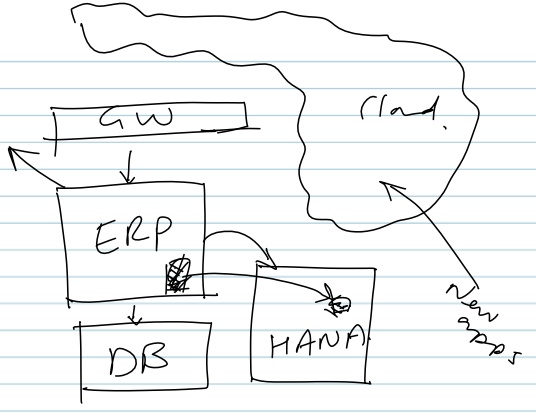SAP's evolving cloud play


But if there is plenty of innovation at the edges, the core still seems fairly static. The lightbulb still has not gone on that if on-demand functionality can be delivered for sub-$100 a user a month, is little justification for on-premise price points to be 10, 15, 20x that. That if Apple and Google and amazon can build mobile ecosystems of hundreds of thousands of applications and games with a cottage industry of entrepreneurs, SAP cannot continue to magically expect its current SI and outsourcing partners to match that speed or those price points. If small teams can build fairly ambitious HANA applications part-time in a matter of days, SAP’s and its partner’s project time scales need to be similarly compressed. if on-demand benchmarks are showing frequent upgrades and importantly instant propagation throughout the customer base, SAP cannot afford to have old-school and grudging multi-year customer base migrations at the core.
Vinnie's views have already been anticipated by SAP. He could not schedule time to meet Hasso Plattner, co-founder SAP or Vishal Sikka, board member in charge of innovation. They confirmed my earlier assertion that SAP needs to bring new business models to their understanding of the cloud.
During the Wednesday morning keynote, Dr Sikka affirmed what some of us thought might be announced only in a slightly different fashion. It announced that SAP is moving HANA into the cloud in a partnership with Dell-Intel. HANA is the foundation upon which SAP plans to deliver all applications in the future. Including large parts of the core. This is not a trivial matter.
The first major step is to get Gateway running. Slated for general availability in October, largely for legal reasons, the above sketch which Dr Sikka drew for me provides an indication of how this works. What it says:
- New applications will be built in the cloud
- Gateway provides the pathway that connects them to core ECC6 and earlier versions of the Business Suite
- Over time, pieces of core functionality are carved out of ERP and into HANA
SAP has already demonstrated All-in-One running in the cloud so there is clear precedent for an OLTP system operating in this manner. When we met with Dr. Plattner, I reminded him that a year or so ago he said that he wasn't sure (at best) whether the Business Suite could be moved to the cloud. Today he is certain but with the caveat that the timing is unclear and benefits today might be elusive. "The Business Suite was not written for massive parallelization but with HANA it may be possible to shrink the suite. - possibly up to 90%." Even then there has to be a re-write: "I don't want 20 years of ABAP carried forward into new technology. It's just not feasible to...deliver breakthrough performance and cost savings," said Dr. Plattner. In that one statement, Dr Plattner is reiterating what he has said in different ways over the last few years - do not customize at the core ERP level.
Dr Sikka said that highly customised systems will not see huge value - at least in the mid term. Dr Plattner said that the notion of upgrades has to be squashed. "I get this question a lot and I say the same - you have to think differently. The old ways of doing things are gone."
This leads to the question of data center ownership. SAP sold its hosting business a couple of years ago. At the time, we were highly critical of such a move. It has become abundantly clear that if you are going to play at enterprise scale, you have to own your own infrastructure. SAP plans to join that small and exclusive club. "Two years ago we spent about €1 million, last year it was €7 million," said Dr Sikka. He agrees this is a drop in the ocean. SAP will have to match the many millions of dollars Facebook, Google, Amazon, Salesforce and Apple have expended on similar ventures. Where will the money come from? "The board will not require any convincing. Our whole strategy requires a rethinking of how we bring service to market and the data center is a big part of that," said Dr Sikka.
Dr Sikka confirmed there are teams working on the business model to make this all hang together. He confirmed that the notion of Xerox style leasing plus a value based delivery model are high on the agenda. I have other ideas. These were confirmed as desirable by those on the ground. In a conversation with John Appleby of Bluefin Solutions and Vijay Vijayasankar, IBM albeit currently limited to mobile, the message was clear: the AppStore model is the way to go.
See also:
Can SAP see the win-win-win pot of gold that is Sybase? SAP certifies Amazon Web Services for half of its application portfolio, core ERP on deck When Was the Last Time You Thought About Sybase?
It is not simply a matter of revenue. SAP has already produced stats that show storage is one of the largest costs associated with running its systems, far outstripping the cost of running application servers for SAP. Test systems are more costly to operate than production systems. Running in the cloud could dramatically reduce TCO. That's the hope and the implied promise. If successful, it will go a long way towards answering Vinnie's critique.
It will not happen overnight. Neither will it be a miracle cure to the burgeoning cost of 'keeping the lights on.' But the savings numbers SAP is hinting at represent an order of magnitude difference to today's operating cost scenarios.
Today, SAP's developer representatives at the board level seem resolute in their agreement that SAP has to change in order to accommodate a positive move into cloud computing. We will know in a years' time whether they are on the road to success. More important - will SAP deliver on Vinnie's demands for a radical pricing overhaul.